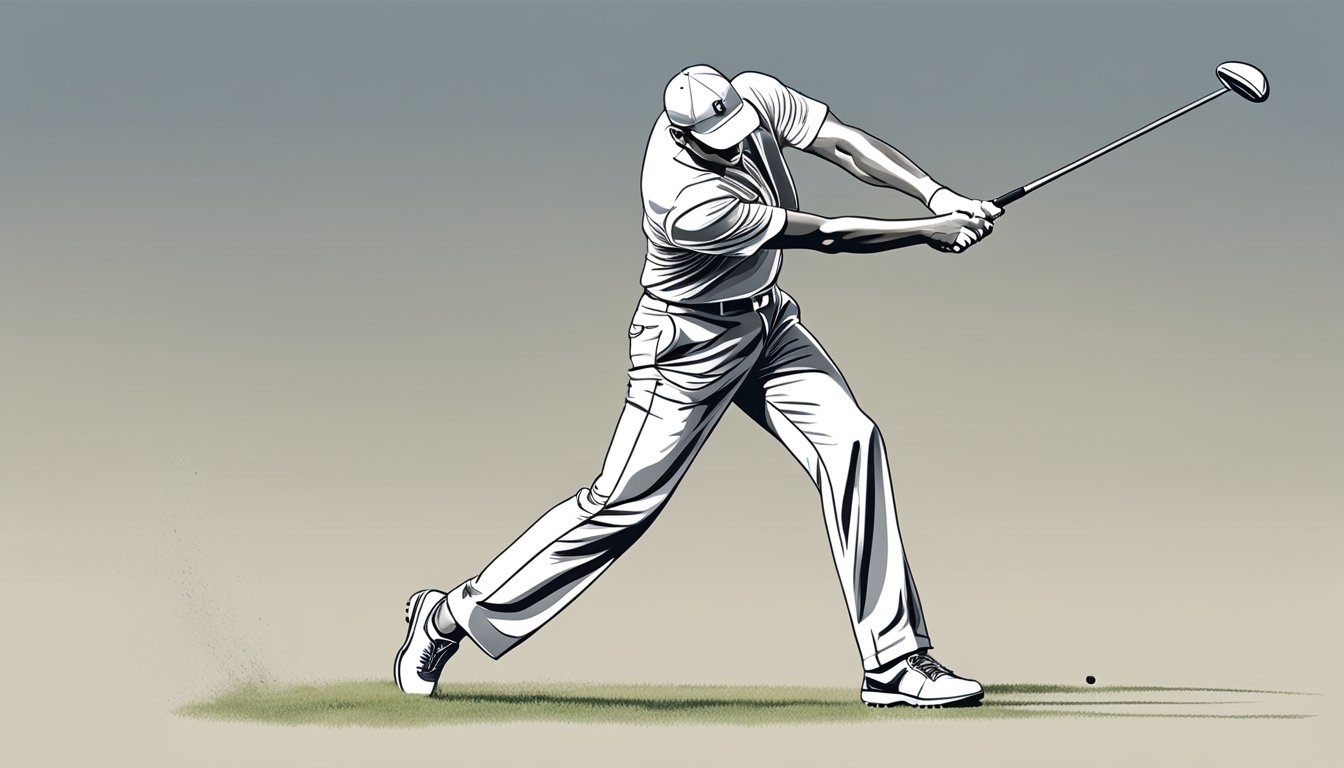If you’re looking to improve your golf game, mastering the perfect swing plane is a crucial step. The swing plane refers to the path that your club takes during your swing, and getting it right can make all the difference in your game. In this article, we’ll cover everything you need to know about the golf swing plane, from understanding the key components of a perfect swing plane to common problems and how to fix them.


To start, it’s important to understand the golf swing plane itself. The swing plane is essentially the path that your club takes as you swing, and it’s critical to get it right if you want to hit the ball accurately and consistently. A perfect swing plane should be on a shallow angle, with the clubhead staying on the same plane both during the backswing and the downswing. This helps ensure that you’re striking the ball in the right spot and with the right amount of force, resulting in more accurate and powerful shots.
In the following sections, we’ll explore the key components of a perfect swing plane, common problems that can arise, and drills and techniques for improving your swing plane. Whether you’re a seasoned golfer or just starting out, mastering the swing plane is a critical step in improving your game. So let’s get started!
Key Takeaways
- The golf swing plane refers to the path that your club takes during your swing, and it’s critical to get it right if you want to hit the ball accurately and consistently.
- A perfect swing plane should be on a shallow angle, with the clubhead staying on the same plane both during the backswing and the downswing.
- Understanding the key components of a perfect swing plane, common problems that can arise, and drills and techniques for improving your swing plane are all critical steps in improving your golf game.
Understanding the Golf Swing Plane
https://www.youtube.com/watch?v=lWW4hAuGS8E&embed=true
When it comes to perfecting your golf swing, understanding the concept of the swing plane is crucial. The swing plane refers to the imaginary flat surface where the club head travels during your swing. It’s essential to maintain the correct swing plane throughout your backswing and downswing to achieve consistent and accurate shots.
During the backswing, focus on keeping the club head on the correct plane as you rotate your body. This ensures that your club is in the optimal position to strike the ball effectively. As you transition into the downswing, maintaining the proper swing plane allows for solid contact and improved ball flight.
Your takeaway and body rotation play a significant role in establishing the correct swing plane. Engage your hips and shoulders to rotate smoothly, ensuring that your swing plane remains consistent. This fluid motion helps align the club head with the ball, leading to better accuracy and distance.
Understanding the golf swing plane’s definition and importance can positively impact your game by promoting a more efficient and effective swing. By focusing on maintaining the correct swing plane throughout your swing, you can enhance your overall performance on the golf course.
Key Components of a Perfect Swing Plane
https://www.youtube.com/watch?v=9DGo6tQ-0ic&embed=true
Getting a perfect swing plane requires a combination of factors that work together to produce a consistent and powerful swing. Here are some key components that you should focus on to achieve the perfect swing plane:
Club
The club is the most important part of your swing. It should be the right length, weight, and flex for your body type and swing style. A club that is too long or too heavy can throw off your swing plane, while a club that is too stiff or too flexible can cause you to lose control of your shots. Make sure you choose a club that suits your body and swing.
Body
Your body plays a crucial role in your swing plane. Your posture, alignment, and balance all affect your swing. Stand with your feet shoulder-width apart, keep your back straight, and tilt your hips forward. This will help you maintain a stable base and a consistent swing plane.
Posture
Good posture is essential to a perfect swing plane. Keep your back straight, your shoulders relaxed, and your arms extended. This will help you maintain a consistent swing plane and generate more power and speed.
Alignment
Proper alignment is critical to a perfect swing plane. Make sure your feet, hips, and shoulders are all aligned with your target. This will help you swing on the correct path and hit the ball straighter and longer.
Clubhead Speed
Clubhead speed is a key factor in your swing plane. The faster your clubhead speed, the more power and distance you can generate. Focus on swinging smoothly and accelerating through the ball to increase your clubhead speed.
Impact
The impact is where it all comes together. Your swing path, clubhead speed, and angle of attack all affect your impact. Make sure you hit the ball on the sweet spot of the clubface and follow through with your swing to achieve a perfect swing plane.
Rotation
Rotation is another critical factor in your swing plane. Your body should rotate around your spine during your swing, with your hips and shoulders turning together. This will help you generate more power and maintain a consistent swing plane.
Lie Angle
The lie angle of your club can affect your swing plane. Make sure your club’s lie angle is adjusted to fit your swing style and body type. This will help you hit the ball straighter and more consistently.
Backswing Plane
Your backswing plane is the path your club follows during your backswing. It should be on the same plane as your downswing to achieve a perfect swing plane. Focus on keeping your club on the correct backswing plane to improve your swing.

Spine Angle
Your spine angle affects your swing plane. Keep your spine angle consistent throughout your swing to maintain a consistent swing plane. This will help you hit the ball straighter and more consistently.
Club Shaft
The shaft of your club affects your swing plane. Make sure your club’s shaft is the right length and flex for your body type and swing style. This will help you maintain a consistent swing plane and generate more power and speed.
Two Plane
There are two types of swing planes: one plane and two plane. A one-plane swing is flatter and more upright, while a two-plane swing is more rounded and more upright. Choose the swing plane that suits your body type and swing style to achieve a perfect swing plane.
Common Swing Plane Problems and How to Fix Them
https://www.youtube.com/watch?v=7vbxG_JROWA&embed=true
Getting your golf swing on plane is crucial to hitting the ball straight and far. However, it’s not always easy to get it right. Here are some common swing plane problems and how you can fix them:

1. Off Plane Swing
If your swing is off plane, it means that your club is not following the correct path during your swing. This can cause a variety of problems, including slices and hooks. To fix this, try using a noodle or headcover drill. Place a noodle or headcover on the ground, angled at 45 degrees, and practice swinging without hitting it. This will help you get a feel for the correct swing path.
2. Slice
If you tend to slice the ball, it’s likely that your swing is coming from outside-in. This means that your club is coming across the ball instead of through it. To fix this, try focusing on your grip and making sure that it’s not too weak. You can also try adjusting your stance so that your shoulders are more aligned with your target.
3. Hook
If you tend to hook the ball, it’s likely that your swing is coming from inside-out. This means that your club is coming from behind you and across the ball. To fix this, try focusing on your grip and making sure that it’s not too strong. You can also try adjusting your stance so that your shoulders are more open to your target.
4. Flat Swing Plane
If your swing plane is too flat, it means that your club is too close to the ground during your backswing. This can cause you to hit the ball fat or thin. To fix this, try focusing on your takeaway and making sure that your club is moving up and away from the ball during your backswing.
5. Upright Swing
If your swing plane is too upright, it means that your club is too high off the ground during your backswing. This can cause you to hit the ball thin or top it. To fix this, try focusing on your takeaway and making sure that your club is moving more around your body during your backswing.

6. Two Plane Swing
If you have a two plane swing, it means that your backswing and downswing are on different planes. This can cause you to hit the ball inconsistently. To fix this, try focusing on your takeaway and making sure that your club is moving on the same plane during your backswing and downswing.
7. One Plane Swing
If you have a one plane swing, it means that your backswing and downswing are on the same plane. This can help you hit the ball consistently. To achieve a one plane swing, try focusing on your takeaway and making sure that your club is moving more around your body during your backswing.
8. Rerouting
If you tend to reroute your swing during your downswing, it means that your club is not following the correct path. This can cause you to hit the ball inconsistently. To fix this, try focusing on your takeaway and making sure that your club is moving on the correct plane during your backswing.
Drills for Improving Your Swing Plane
https://www.youtube.com/watch?v=qzZlM_RH40I&embed=true
Improving your swing plane is key to hitting straighter shots and increasing consistency on the course. Fortunately, there are several drills you can do to help you achieve a more natural, consistent swing.
Alignment Stick Drill
One of the best drills for improving your swing plane is the alignment stick drill. To do this drill, simply place an alignment stick or club on the ground parallel to your target line. As you swing, focus on keeping your clubhead on the same plane as the alignment stick throughout your swing. This drill provides instant feedback and helps you develop a better sense of depth and aim.
Turn and Push Drill
Another effective drill is the turn and push drill. Start by taking your normal backswing, but as you transition to your downswing, focus on pushing your lead elbow toward your target. This helps you maintain a more consistent swing plane and encourages a smoother transition from the top of your backswing to the finish.
Wrist Hinge Drill
Improving your wrist hinge can also help you achieve a better swing plane. To do this drill, start by taking your normal backswing, but as you reach the top, focus on hinging your wrists to create a 90-degree angle between your left arm and the club shaft. This helps you maintain a consistent swing plane and encourages a more powerful downswing.
Fundamental Drills
Finally, practicing fundamental drills such as grip, aim, and posture can also help you achieve a better swing plane. By focusing on the basics, you can develop a more natural, consistent swing that produces straighter shots and better rhythm.
Incorporating these drills into your practice routine can help you achieve a better swing plane and improve your overall game on the course. Remember to focus on natural, consistent movements and use instant feedback to make adjustments as needed. With practice and dedication, you can achieve the perfect golf swing plane.

Tools and Techniques for a Better Swing Plane
https://www.youtube.com/watch?v=X-sfJ3EeNOQ&embed=true
Improving your golf swing plane can be a challenging task, but with the right tools and techniques, it can become an achievable goal. Here are some tips that will help you achieve a better swing plane:
Use Proper Setup and Athletic Posture
Having a proper setup and athletic posture is crucial for a powerful and efficient swing. When setting up, make sure your feet are shoulder-width apart, and your knees are slightly bent. Your spine should be straight, and your shoulders should be relaxed. This position will allow you to maintain your balance and generate more power throughout your swing.
Focus on Your Lead Arm
Your lead arm plays a significant role in your swing plane. Keep your lead arm straight throughout your swing to ensure you are on the right plane. This technique will help you achieve a consistent and accurate swing.
Follow-Through and Timing
The follow-through is as important as the backswing. Make sure you complete your swing and follow through with your club. This technique will help you maintain your balance and keep your swing on plane. Timing is also crucial to ensure that your swing is efficient and powerful.

Single Plane Swing
The single plane swing is a technique that has gained popularity on the PGA Tour. This technique involves keeping your swing on a single plane, which can help you achieve a more consistent and accurate swing.
Use Training Aids
Training aids such as alignment sticks, swing trainers, and impact bags can help you develop muscle memory and achieve a better swing plane. These tools can help you practice your swing and develop a more efficient and powerful swing.
Learn from the Experts
Golf Digest is a great resource for learning about the perfect golf swing. The magazine has articles and videos on different aspects of the swing, including the driver swing plane, angle of attack, and iron shots. You can also learn from the greats such as Ben Hogan and study their techniques to improve your swing.
In conclusion, improving your swing plane takes time and practice, but with the right tools and techniques, you can achieve success. Focus on your setup, lead arm, timing, and follow-through to ensure a more efficient and powerful swing. Use training aids and learn from the experts to develop your skills and achieve a better golf swing.
Frequently Asked Questions
https://www.youtube.com/watch?v=mVqcElaB1eE&embed=true

What are some effective golf swing plane drills using alignment sticks?
Alignment sticks are a popular training aid used by many golfers to improve their swing plane. One effective drill is to place two alignment sticks on the ground, parallel to your target line. Position one stick just outside your front foot and the other just inside your back foot. Then, take your normal stance and swing the club back and forth, making sure to keep the clubhead between the two sticks. This drill will help you maintain a consistent swing plane throughout your swing.
How can a golf swing plane trainer help improve my swing?
A golf swing plane trainer is a device that helps you practice your swing plane. It typically consists of a metal rod with a hoop or other attachment at the top. You can attach the trainer to your club and practice your swing, making sure to keep the clubhead inside the hoop throughout your swing. Using a swing plane trainer can help you develop muscle memory for a consistent swing plane, leading to more accurate shots on the course.
What is the ideal degree for a golf swing plane?
There is no one-size-fits-all answer to this question, as the ideal degree for a golf swing plane will depend on your individual swing. However, most golfers aim for a swing plane that is slightly flatter than the angle of their spine at address. This will help you make solid contact with the ball and avoid slicing or hooking your shots.
Are there any helpful golf swing plane apps available?
Yes, there are many golf swing plane apps available for both iOS and Android devices. These apps use your phone’s accelerometer to track your swing plane and provide feedback on your swing. Some popular options include Golf Swing Plane, Golf Swing Analyzer, and Swing Profile Golf Analyzer.
What are some differences between driver swing plane and iron swing plane?
The swing plane for a driver is typically flatter than the swing plane for an iron. This is because drivers have longer shafts and larger clubheads, which require a flatter swing plane to make solid contact with the ball. Additionally, the ball position for a driver is more forward in your stance, which also affects your swing plane.
Can a single plane swing improve my game?
A single plane swing is a type of swing that is characterized by a flatter swing plane and less wrist action. While this type of swing can be effective for some golfers, it may not be the best choice for everyone. If you are interested in trying a single plane swing, it is important to work with a qualified instructor to ensure that you are using proper technique and that the swing is right for your individual game.










